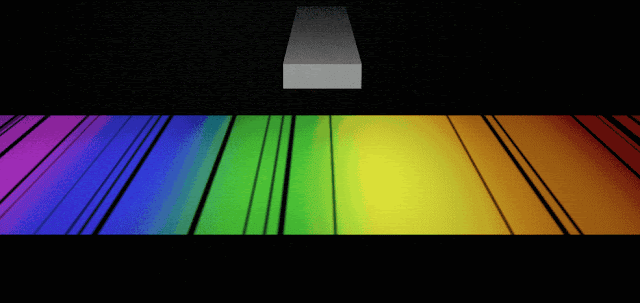NASA - Mars 2020 Perseverance Rover logo.
Feb. 20, 2021
HiRISE Captured Perseverance During Descent to Mars
Image above: The descent stage holding NASA’s Perseverance rover can be seen falling through the Martian atmosphere, its parachute trailing behind, in this image taken on Feb. 18, 2021, by the High Resolution Imaging Experiment (HiRISE) camera aboard the Mars Reconnaissance Orbiter. The ancient river delta, which is the target of the Perseverance mission, can be seen entering Jezero Crater from the left.
HiRISE was approximately 435 miles (700 kilometers) from Perseverance and traveling at about 6750 mile per hour (3 kilometers per second) at the time the image was taken. The extreme distance and high speeds of the two spacecraft were challenging conditions that required precise timing and for Mars Reconnaissance Orbiter to both pitch upward and roll hard to the left so that Perseverance was viewable by HiRISE at just the right moment.
The orbiter’s mission is led by NASA’s Jet Propulsion Laboratory in Southern California. JPL, a division of Caltech, manages the Mars Reconnaissance Orbiter for NASA’s Science Mission Directorate in Washington. Lockheed Martin Space in Denver, built the spacecraft. The University of Arizona provided and operates HiRISE. Image Credits: NASA/JPL-Caltech/University of Arizona.
Perseverance Gets Ready to Touch Down
Image above: This high-resolution still image is part of a video taken by several cameras as NASA’s Perseverance rover touched down on Mars on Feb. 18, 2021. A camera aboard the descent stage captured this shot.
A key objective for Perseverance’s mission on Mars is astrobiology, including the search for signs of ancient microbial life. The rover will characterize the planet’s geology and past climate, pave the way for human exploration of the Red Planet, and be the first mission to collect and cache Martian rock and regolith (broken rock and dust).
Subsequent NASA missions, in cooperation with ESA (the European Space Agency), would send spacecraft to Mars to collect these cached samples from the surface and return them to Earth for in-depth analysis. Image Credits: NASA/JPL-Caltech.
Perseverance’s Big Wheel
Image above: This high-resolution image shows one of the six wheels aboard NASA’s Perseverance Mars rover, which landed on Feb. 18, 2021. The image was taken by one of Perseverance’s color Hazard Cameras (Hazcams).
The Mars 2020 mission is part of a larger program that includes missions to the Moon as a way to prepare for human exploration of the Red Planet. JPL, which is managed for NASA by Caltech in Pasadena, California, built and manages operations of the Perseverance and Curiosity rovers. Image Credits: NASA/JPL-Caltech.
Perseverance’s First Full-Color Look at Mars
Image above: This is the first high-resolution, color image to be sent back by the Hazard Cameras (Hazcams) on the underside of NASA’s Perseverance Mars rover after its landing on Feb. 18, 2021.
The Mars 2020 mission is part of a larger program that includes missions to the Moon as a way to prepare for human exploration of the Red Planet. JPL, which is managed for NASA by Caltech in Pasadena, California, built and manages operations of the Perseverance and Curiosity rovers. Image Credits: NASA/JPL-Caltech.
NASA's Perseverance Rover Lands Successfully on Mars (Highlight Reel)
Video above: After a seven-month-long journey, NASA’s Perseverance Rover successfully touched down on the Red Planet on Feb. 18, 2021. Mission controllers at NASA's Jet Propulsion Laboratory in Southern California celebrate landing NASA's fifth -- and most ambitious -- rover on Mars.
A key objective for Perseverance’s mission on Mars is astrobiology, including the search for signs of ancient microbial life. The rover will characterize the planet’s geology and past climate, pave the way for human exploration of the Red Planet, and be the first mission to collect and cache Martian rock and regolith.
Also flying with Perseverance is NASA’s Ingenuity helicopter, which will attempt to show controlled, powered flight is possible in the very thin Martian atmosphere. Video Credits: NASA/JPL.
Related articles:
NASA’s Mars Helicopter Reports In
https://orbiterchspacenews.blogspot.com/2021/02/nasas-mars-helicopter-reports-in.html
NASA’s Perseverance Rover Sends Sneak Peek of Mars Landing
https://orbiterchspacenews.blogspot.com/2021/02/nasas-perseverance-rover-sends-sneak.html
Touchdown! NASA's Mars Perseverance Rover Safely Lands on Red Planet
https://orbiterchspacenews.blogspot.com/2021/02/touchdown-nasas-mars-perseverance-rover.html
Explore the Jezero neighbourhood
https://orbiterchspacenews.blogspot.com/2021/02/explore-jezero-neighbourhood.html
The Mars Relay Network Connects Us to NASA’s Martian Explorers
https://orbiterchspacenews.blogspot.com/2021/02/the-mars-relay-network-connects-us-to.html
Related links:
Mars Reconnaissance Orbiter (MRO): http://www.nasa.gov/mission_pages/MRO/main/index.html
ESA & ROSCOSMOS ExoMars: https://www.esa.int/Science_Exploration/Human_and_Robotic_Exploration/Exploration/ExoMars
Mars Perseverance Rover: http://www.nasa.gov/perseverance and https://mars.nasa.gov/mars2020/
Images (mentioned), Video (mentioned), Text, Credits: NASA/Tony Greicius/Brian Dunbar.
Greetings, Orbiter.ch


















































